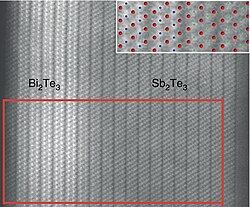Antimony telluride
 Electron micrograph of a seamless Bi2Te3/Sb2Te3 heterojunction and its atomic model (blue: Bi, green: Sb, red: Te)[1]
| |
| Names | |
|---|---|
| Other names
antimony telluride, antimony(III) telluride, antimony telluride, diantimony tritelluride
| |
| Identifiers | |
3D model (
JSmol ) |
|
| ChemSpider | |
ECHA InfoCard
|
100.014.074 |
PubChem CID
|
|
| |
| |
| Properties | |
| Sb2Te3 | |
| Molar mass | 626.32 g·mol−1 |
| Appearance | grey solid |
| Density | 6.50 g cm−3[2][3] |
| Melting point | 620 °C (1,148 °F; 893 K)[2] |
| Band gap | 0.21 eV[4] |
Thermal conductivity
|
1.65 W/(m·K) (308 K)[5] |
| Structure | |
Rhombohedral, hR15
| |
| R3m, No. 166[6] | |
a = 0.4262 nm, c = 3.0435 nm
| |
Formula units (Z)
|
3 |
| Hazards | |
| NIOSH (US health exposure limits): | |
PEL (Permissible)
|
TWA 0.5 mg/m3 (as Sb)[7] |
REL (Recommended)
|
TWA 0.5 mg/m3 (as Sb)[7] |
| Related compounds | |
Other anions
|
Sb2Se3
|
Other cations
|
As2Te3
Bi2Te3 |
Except where otherwise noted, data are given for materials in their standard state (at 25 °C [77 °F], 100 kPa).
| |
Antimony telluride is an
Crystalline structure
Sb2Te3 has a rhombohedral crystalline structure.[8] The crystalline material comprises atoms covalently bonded to form 5 atom thick sheets (in order: Te-Sb-Te-Sb-Te), with sheets held together by van der Waals attraction. Due to its layered structure and weak inter-layer forces, bulk antimony telluride may be mechanically exfoliated to isolate single sheets.
Synthesis
Although antimony telluride is a naturally occurring compound, select stoichiometric compounds may be formed by the reaction of antimony with tellurium at 500–900 °C.[3]
- 2 Sb(l) + 3 Te(l) → Sb2Te3(l)
Applications
Like other
Doping Sb2Te3 with iron introduces multiple Fermi pockets, in contrast to the single frequency detected for pure Sb2Te3, and results in reduced carrier density and mobility.[9]
Sb2Te3 forms the
Like
References
- ^ PMID 26572278.
- ^ ISBN 1-4398-5511-0.
- ^ ISBN 978-0-08-037941-8.
- PMID 10035559.
- PMID 9981020.
- .
- ^ a b NIOSH Pocket Guide to Chemical Hazards. "#0036". National Institute for Occupational Safety and Health (NIOSH).
- .
- S2CID 119401198.
- .
